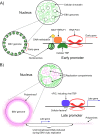An Epigenetic Journey: Epstein-Barr Virus Transcribes Chromatinized and Subsequently Unchromatinized Templates during Its Lytic Cycle
- PMID: 30700606
- PMCID: PMC6450099
- DOI: 10.1128/JVI.02247-18
An Epigenetic Journey: Epstein-Barr Virus Transcribes Chromatinized and Subsequently Unchromatinized Templates during Its Lytic Cycle
Abstract
The Epstein-Barr virus (EBV) lytic phase, like those of all herpesviruses, proceeds via an orderly cascade that integrates DNA replication and gene expression. EBV early genes are expressed independently of viral DNA amplification, and several early gene products facilitate DNA amplification. On the other hand, EBV late genes are defined by their dependence on viral DNA replication for expression. Recently, a set of orthologous genes found in beta- and gammaherpesviruses have been determined to encode a viral preinitiation complex (vPIC) that mediates late gene expression. The EBV vPIC requires an origin of lytic replication in cis, implying that the vPIC mediates transcription from newly replicated DNA. In agreement with this implication, EBV late gene mRNAs localize to replication factories. Notably, these factories exclude canonical histones. In this review, we compare and contrast the mechanisms and epigenetics of EBV early and late gene expression. We summarize recent findings, propose a model explaining the dependence of EBV late gene expression on lytic DNA amplification, and suggest some directions for future study.
Keywords: DNA methylation; Epstein-Barr virus; chromatin; epigenetics; herpesviruses; histones; transcription.
Copyright © 2019 American Society for Microbiology.
Figures



References
-
- Chevallier-Greco A, Manet E, Chavrier P, Mosnier C, Daillie J, Sergeant A. 1986. Both Epstein-Barr virus (EBV)-encoded trans-acting factors, EB1 and EB2, are required to activate transcription from an EBV early promoter. EMBO J 5:3243–3249. doi:10.1002/j.1460-2075.1986.tb04635.x. - DOI - PMC - PubMed
Publication types
MeSH terms
Substances
Grants and funding
LinkOut - more resources
Full Text Sources

